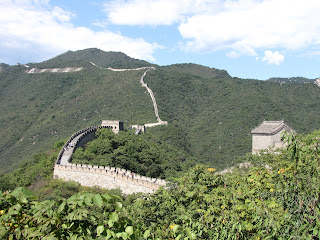When last we left my narrative we were having dinner in Beijing. Today we join the narrative still in Beijing, getting ready to take a tour of the Great Wall.
But to back up...we had breakfast that morning at Starbuck's at the mall. No kidding. Here I am talking to the kids before they go to bed:
Our tour was arranged through our hotel (Raffles Beijing, AWESOME in the way that all colonial-era hotels are), and we met up with our guide Andy as well as a driver. This is the way to tour the area, rather than on a bus. We got a chance to ask tons of questions and linger as long as we liked in different places.
 |
| Bill and me with our tour guide, Andy. |
 |
| From the top of the Ming Tombs. These are the "Dragon's Teeth" mountains. |
 Usually if you take a tour from Beijing to the Great Wall you will also have the Ming Tombs included. They are an okay site, but I think mainly they are something in the area to look at rather than just seeing the wall. In usual Chinese fashion, the tombs are a series of gates (single walls with openings) and temples, leading to the innermost temple. At the Ming tombs, this is actually a hill where the emperors are buried. Their actual graves don't seem to be marked.
Usually if you take a tour from Beijing to the Great Wall you will also have the Ming Tombs included. They are an okay site, but I think mainly they are something in the area to look at rather than just seeing the wall. In usual Chinese fashion, the tombs are a series of gates (single walls with openings) and temples, leading to the innermost temple. At the Ming tombs, this is actually a hill where the emperors are buried. Their actual graves don't seem to be marked. |
| One of the Ming gates. |
Here's my impression of the Wall: The emperors who built it did it because they could. They decided to block the Mongols off, and this wall their idea. Building it took massive manpower, but manpower is something that China has always had in abundance. Essentially, the answer to the problem of keeping enemies out was to see how many people you could throw at the problem. There is nothing elegant about this solution, especially when you compare it with, say, Roman architecture. Compare these two pictures:
The Romans valued utility and efficiency, and they were happy to get some beauty along the way. It seems to me that the scale and style of Chinese solutions is to just throw more people at a problem. Elegance and efficiency are not highly valued--labor is too cheap, and more people are always easy to come by.
One thing that isn't easy to come by in China, it seems to me, is food. We passed through many villages along the way to the Wall. Houses are built right on the road, even in the smallest settlements. Any available patch of land is cultivated. We saw corn grown in culverts, peach trees everywhere, even basketball courts used to dry corn out after harvesting. The most shocking cultivation was right at the Great Wall--the trees you see around are actually chestnut trees. They were being harvested all around us as we walked on the Wall.
Our guide found it astonishing that we owned a 45-acre farm just for horses, and didn't grow any food at all on it. He said he couldn't imagine that much land with no crop or farm animal. He asked us about it several times.
Downton Abbey starts tonight, so I will leave my post here. Hopefully I'll be able to finish Beijing later this week.






No comments:
Post a Comment